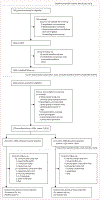Effect of a spatial repellent on malaria incidence in an area of western Kenya characterised by high malaria transmission, insecticide resistance, and universal coverage of insecticide treated nets (part of the AEGIS Consortium): a cluster-randomised, controlled trial
- PMID: 39709979
- PMCID: PMC11841304
- DOI: 10.1016/S0140-6736(24)02253-0
Effect of a spatial repellent on malaria incidence in an area of western Kenya characterised by high malaria transmission, insecticide resistance, and universal coverage of insecticide treated nets (part of the AEGIS Consortium): a cluster-randomised, controlled trial
Abstract
Background: Spatial repellent products are used for prevention of insect bites, and a body of evidence exists on spatial repellent entomological efficacy. A new option for vector control, spatial repellent products are designed to release active ingredient into the air for disruption of human-vector contact thereby reducing human exposure to mosquito-borne pathogens. Clinical trials have shown spatial repellent epidemiological efficacy against Aedes-borne viruses but inconclusive outcomes against malaria. We aimed to show and quantify the protective efficacy of spatial repellents in reducing malaria infection incidence in Busia County, Kenya.
Methods: A prospective, cluster-randomised, controlled trial in Busia County, western Kenya was done to quantify the efficacy of a transfluthrin-based spatial repellent against human malaria infection following mass distribution of insecticide treated nets. Investigators, staff, and study participants were masked to cluster allocation. Infection incidence was measured by microscopy in children aged 6 months to younger than 10 years during a 4-month baseline (March-July 2021) and 24-month follow-up period with intervention (October, 2021-October, 2023). From 58 clusters (29 intervention, 29 placebo), a total of 1526 and 1546 participants from two consecutive, 12-month cohorts were assessed for first-time malaria infection (primary endpoint) by survival analysis at interim and end-of-trial timepoints, respectively. This trial is registered with ClinicalTrials.gov, NCT04766879 and is complete.
Findings: The outcome of the primary endpoint indicated that spatial repellents significantly reduced the hazard rate of first-time malaria infection by 33·4% (95% CI 11·1-50·1; p=0·0058) and the hazard rate of overall new malaria infections by 32·1% (15·9-45·2; p=0·0004). No reported adverse events and serious adverse events were deemed to be associated with the spatial repellent.
Interpretation: Our trial provides the first evidence of a demonstrative spatial repellent protective efficacy in reducing risk of malaria infection in an African setting characterised by high malaria transmission, pyrethroid resistant malaria vectors, and high coverage of insecticide treated nets. Results support spatial repellent products as a beneficial component of malaria prevention.
Funding: This study was funded by Unitaid to the University of Notre Dame.
Copyright © 2024 Elsevier Ltd. All rights reserved, including those for text and data mining, AI training, and similar technologies.
Conflict of interest statement
Declaration of interests The authors declare no competing interests.
Figures



Comment in
-
Beyond repellents: spatial emanators for the control of malaria in Africa.Lancet. 2025 Jan 11;405(10473):101-103. doi: 10.1016/S0140-6736(24)02754-5. Epub 2024 Dec 19. Lancet. 2025. PMID: 39709978 No abstract available.
References
-
- WHO. World malaria report. 2023. https://www.who.int/teams/global-malaria-programme/reports/world-malaria... (accessed June 23, 2024).
-
- WHO, UNICEF. Global vector control response 2017-2030. 2017. https://www.who.int/publications/i/item/9789241512978 (accessed June 23, 2024).
Publication types
MeSH terms
Substances
Associated data
Grants and funding
LinkOut - more resources
Full Text Sources
Medical

